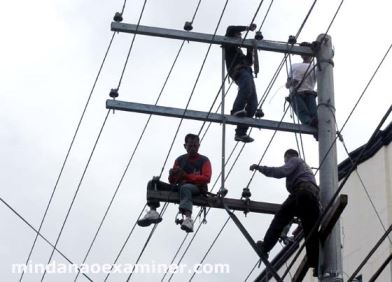
Linemen of the Zamboanga City Electric Cooperative work on a high-tension electrical wire without safety helmet, leather or rubber gloves and safety shoes. Zamboanga City is experiencing long hours of pestering power outages the past weeks and the electric cooperative blames the lack of power supply in Mindanao, but despite this problem it is pushing for new hike in electricity charges. (Mindanao Examiner Photo)
ZAMBOANGA CITY (Mindanao Examiner / Oct. 24, 2012) – Zamboanga, touted as one of the highly-urbanized cities in the Philippines, is now suffering from pestering power outages and despite this problem, the local power cooperative is pursuing a new hike in electricity charges.
Residents have been complaining of long hours of blackout almost several times every day and that this has been going on for weeks now. The power outages also damaged many of their appliances.
The Zamboanga City Electric Cooperative has blamed the lack of sufficient power supply in Mindanao as the cause of the blackout. It said this is aggravated by the maintenance shutdown of the coal-fired power plant run by Steag State Power in Misamis Oriental province.
Just this year, the Zamboanga City Electric Cooperative also inked a deal with Aboitiz Power’s Therma Marine Incorporated (TMI) for additional 18 MW (megawatts) of electricity and putting the burden of paying P37 million to the consumers.
TMI, which operates power barges in Mindanao, is also supplying electricity to other areas in Mindanao due to power curtailment imposed by the National Grid Corporation of the Philippines, which is owned by tycoon Henry Sy, Jr.
The Aboitiz Group has been involved in the Philippine electricity industry the past seven decades. It said it would allocate P35 billion more for Mindanao to increase power capacity in the region which is suffering from electricity shortage.
But residents in Davao where Aboitiz Power plans to put up coal-fired power plants are strongly protesting because of the pollution brought about by this facility.
Mindanao needs about 1,597 MW daily and its current power output is below 1,200 MW.
In Zamboanga City, the daily power consumption is about 100 MW and the Zamboanga City Electric Cooperative gets a little over half of its total requirements.
With the power outages in Zamboanga, the Conal Holdings Corporation now is putting up a 100 MW coal-fired power plant, despite strong opposition from many residents in the village of Talisayan where it plans to operate.
Conal Holdings has already signed a memorandum of agreement with the Zamboanga City Freeport and Economic Zone for the fossil fuel power station. And the coal-fired power plant was even granted a so-called “no-objection” resolution by the Zamboanga City Council, although a few council members have rejected the project because of pollution and its effect to the environment.
Last year, the head of the Zamboanga City Electric Cooperative was sacked by the National Electrification Administration (NEA) over anomalous transactions involving millions of pesos in funding.
Many of its incumbent and former board directors were also removed and disqualified from holding any position in rural electric cooperatives in the country. Those accused denied all allegations against them and said all their transactions were legal and sanctioned by the NEA which had denied it.
Local business and civil groups, and politicians questioned the extravagant spending of the power firm despite its ballooning debts which reached over P1 billion.
NEA installed Engineer Jesus Castro as Project Supervisor to oversee the operation of the cooperative, but he was also removed due to alleged anomalies.
Communist rebel leaders said the power crisis in Mindanao is a “grandiose show” to deceive the people and force them to accept the privatization of power plants and the construction of dirty coal-fired power plants.
“The current power plants on the island are capable of producing enough electricity for all of Mindanao’s regions. The power plants are purposely not being operated at full capacity to create an artificial power shortage,” said Jorge Madlos, of the National Democratic Front.
Madlos was referring to the state-run hydropower and geothermal plants.
“In Mindanao, the Alcantara, Dominguez and Aboitiz families exploited the situation to expand their power generation enterprises in the last two decades. Now, Henry Sy is using the same scheme to slowly buy out private and government-owned power plants and monopolize control over the island’s energy sector. Since the energy sector is deregulated, Sy can raise power rates whenever he wants after he gains possession of the island’s power plants,” he said.
“The monopolization of the island’s energy sector will further raise power rates and cause more suffering to the people of Mindanao. At present, power rates are already high due to profit-hungry independent power producers and the imposition of the Value-Added Tax.”
The state-run Power Sector Assets and Liabilities Management Corporation said it was planning to privatize the Agus and Pulangi hydropower plants in Mindanao for reasons that the government cannot afford its maintenance. (Mindanao Examiner)


